Long Island Gum Tissue Growth
Overcoming Common Causes of Gum Loss – Recession
The loss of gum tissue can be caused by several different conditions or events. Understanding the dynamics of the actual loss is critical for selecting the correct procedures and materials for achieving a desirable outcome that has the best endurance.
The failure to diagnose the actual cause of tissue failure oftentimes results in having treatment that can fail within a short amount of time.
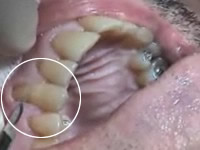
Single tooth recession caused by abfraction
Single Tooth Abfractions
While not the most common type of gum loss, abfractions represent one of the most mysterious causes.
The tooth pictured here shows a unique recession condition that is commonly caused when a tooth is either overbrushed, is too far into occlusion (the tooth hits before others), or is subjected to grinding or bruxism.
The tiny micro-movement of the gum tissue itself (via over brushing) or the imperceptible movements of the tooth structure (via inappropriate occlusion) causes healthy gum tissue to pull away or retreat from the “movement area.”
Repairing or replacing the missing tissue is usually accomplished with grafting gum tissue that is harvested from the palate, or roof of the mouth.
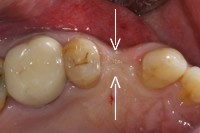
Old Extraction: Bone and Gum Loss
Untreated Extractions – Old Extractions
Gum tissue “follows” bone tissue. If bone tissue loss occurs, the gum tissue telegraphs the loss. What may appear to be the loss of gum tissue is actually the loss of bone. An old tooth extraction is a good example of this type of event.
An untreated extraction site will tend to develop a dent or caving-in appearance of bone into the socket where the tooth roots once were. Gum tissue rapidly follows the loss bone which can create a loss of gum tissue height and width (measured from the front (anterior) side of the jawbone to the tongue side.
An old extraction site that is eventually prepared for a dental implant can be treated with tissue augmentation procedures such as basic ridge splitting, bone grafting and connective tissue (gum) grafts.
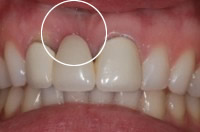
Bridgework Causing Gum Recession
Dental Bridges and Gum Tissue
Bridgework dentistry is the most popular treatment for replacing one or more teeth within the upper or lower jaw. By definition, there is a “bridging effect” that can span almost any span of missing teeth.
Gum recession almost routinely occurs at those locations where teeth no longer exist. The tissue loss can occur both in gum height (where it meets the individual bridge teeth) or in width where the gums are acquiring at flattened or hollowed out effect.
Gum recession will expose the junction between the roof and the man-made material. This can create a displeasing appearance and gaps between the bridge and gum tissue.
The above picture shows one of the most common gum recession events that many bridgework patients complain about. The appearance of marginal edges of the bridge can show characteristics of how the bridge was fabricated, the accumulation of bacteria at the margins or even gaps between the bridge and gum tissue.
The soft tissue areas directly above this 3 unit bridge (circled area) readily shows a loss of “plumpness” of gum tissue that exists on the neighboring, natural teeth. The cosmetic result of this bridgework produces the perception that “this is a bridge”… definitely not the goal of cosmetic reconstruction.
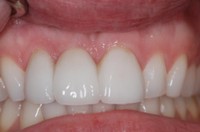
Gum Growing Success
The Fix
Dr. Brant uses a proprietary periodontal treatment procedure that enables re-growth of gum tissue where it is needed the most.
Careful attention to tissue conditions enables the growth of tissue both in height and in thickness that creates a result that matches the handiwork of Mother Nature.
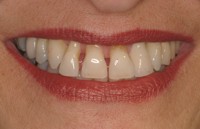
Gum Disease Tissue Losses
Degree of Gum Disease – Periodontitis
Gingivitis and it’s developmentally older cousin, periodontitis, is well known to be the major cause of gum recession.
Diagnosed and treated early, Dr. Brant provides grafting procedures that can produce dramatic effects both cosmetically and functionally that can provide superb prospects for long term endurance.
The adjacent photos reveal serious loss of bone tissue and gum tissue caused by adult gum disease. Because the patient was proactive in seeking treatment, the tissue rebuilding and re-growth process was required on just a few teeth.
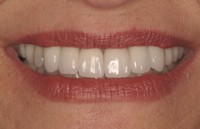
Periodontal Smile Reconstruction Success
Idiopathic Root Resorption
Resorption of tissue that can include the resorbing of gums, bone and even individual teeth occurs for many patients that has no known cause. It just “happens.” In most cases the usual recommendation is for extraction of the affected tooth and any similarly affected adjacent tissue.
Bone and tissue grafting is used as necessary to restore optimal tissue health that enables a patient to take advantage of the best treatment choice, a dental implant. The procedures and products that typically accompany advanced implant dentistry rebuilds all affected tissues with superb long term predictability.
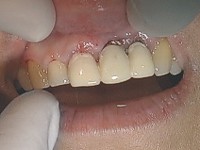
Implant Failure causes Gum Tissue Failure
Dental Implant Failure and Gum Loss
The successful integration of new tissue with old typically refers to the processes that are involved with modern implant dentistry. Central to any successful dental implant procedure is the total osseointegration of implant devices and grafting products with a patient’s tissue.
Attention to detail that focuses upon appropriate implant device choice (different sizes for different locations and tissue conditions), anticipated biting forces, the patient’s medication history and oral health maintenance habits are important considerations for patients to understand when they are motivated to promote the best endurance possible.
Common technical errors, unfortunately, occur that can result in bad or failed osseointegration that can lead to overall treatment failure. Errors in diagnosis and execution can be blamed for clinical failure. Proper training and clinical experience are key to clinical success.
The above picture that depicts unhealthy gums was caused by a dental implant procedure failure. In this particular case, the implant required replacement with new grafting products.
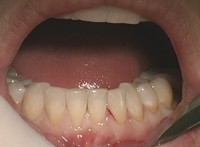
Congenital Thin Gum Root Coverage
Thin Gums
It is not uncommon for many patients to be predisposed to having thin gums as opposed to plump gum tissue.
The basic aging process can cause thin gum tissue to prematurely recede, causing tooth roots to become more exposed. While not a disease issue … special gum grafting treatments may be needed to prevent unwanted recession.
The above pre-op photo shows a condition of thin gum tissue that is just beginning to slightly recede in an older adult patient.
Left untreated, this condition could lead to extreme tooth sensitivity once the roots are fully exposed. Susceptibility to infection would also increase.
Making Thin Gums Thick
Intervening early enables Dr. Brant to use a Periodontal Tunneling Procedure that inserts graft material and incorporates special gum lifting sutures that physically “lifts” the gum tissue onto the tooth structures.
His proprietary suturing methods essentially eliminates scar tissue issues and lifts the new plump gum line into position that provides good root coverage that is second best only to Mother Nature.
Many patients who have severely receding gum lines on their upper or lower teeth now have a treatment option to grow new gum tissues where it is needed the most.
Click here to see how Dr. Brant uses alloderm grafting for an upper arch of recessed gums.
Patients seeking additional information or details about specialized treatment sessions or appointments are invited to contact Dr. Brant directly via our on-line Ask The Dentist form during or after usual business hours.
Call: 631.584.4395
Dr. Brant can provide examples of how executives from a variety of industries and institutions are provided with a custom utilization of our services to deliver treatment outcomes for nearly any kind of time schedule.
